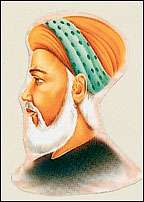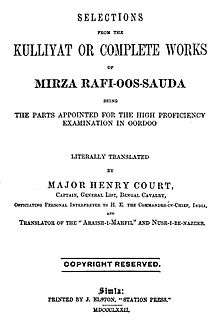Mirza Muhammad Rafi Sauda


Mirza Muhammad Rafi 'Sauda' (Urdu: مِرزا مُحمّد رفِیع سَودا ), (1713–1781) was an Urdu poet in Delhi, India. He is known for his Ghazals and Urdu Qasidas.[1]
Biography
He was born in 1713 [2] in Shahjahanabad (i.e. Old Delhi), where he was also brought up.[3][4] At the age of 60 or 66, he moved to Farrukhabad (with Nawab Bangash),[2] and lived there from 1757 to about 1770.[3][5] In A.H. 1185 (1771–72) he moved to the court of Nawab of Awadh (then in Faizabad) and remained there until his death.[3] When Lucknow became the state capital, he came there with Nawab Shujauddaula.[4]
Ustads and shagirds
Sulaimān Qulī Ḳhān 'Vidād' and Shāh Ḥātim were his Ustads (teachers of Urdu poetry).[2][7] King Shah Alam was Shagird (student of Urdu poetry) of Sauda.[2] He was also Ustad of Shujauddaulla. Nawab Āṣif ud-Daulah gave him title of Malkushshu'ara and annual pension of Rs 6,000.[2]
Works
Initially he composed in Persian, but switched to Urdu on the advice of his ustad, Ḳhān-e Ārzū.[2] His work was translated in 1872 by Major Henry Court, Captain, Bengal Cavalry.[8] Kulliyat of Sauda was compiled by Ḥakīm Sayyid Aṣlaḥ. ud-Dīn Ḳhān wrote the introduction.[2] Sauda's works from his Kulliyat are:[9]
- Masnavi dar hajv-e hakim ghaus مثنوی در ھجوِ حکیم غوث
- Masnavi dar hajv-e amir-a daulatmand bakhil مثنوی در ھجوِ امیرِ دولت مند بخیل
- Masnavi dar ta'rif-e shikar مثنوی در تعریفِ شکار
- Masnavi dar hajv-e pil rajah nripat singh مثنوی در ھجو پِل راجن نری پت سنگھ
- Masnavi dar hajv-e sidi faulad khan kotval-e shahjahanabad مثنوی در ھجو سیدّی فولاد خان کوتوالِ شاجہان آباد
- Masnavi dar hajv-e fidvi mutavatan-e panjab kih darasal baqal bachchah bud
مثنوی در ھجو فدوی مُطاوِتانِ پنجاب کی دراصل بیقل بچاہ بد
- Masnavi dar hajv-e chipak mirza faizu مثنوی در ھجو چپک مرزا فیضو
- Qissah-e darvesh kih iradah-e ziyarat-e ka'bah kardah bud قصّہِ درویش کہ ارادہِ زیارتِ کعبہ کرد بد
- Mukhammas-e shahr ashob مخاماصِ شہر آشوب
- Qasidah dar madh-e navab vazir imad ul-mulk قصیدہ درمدہِ نواب وزیر عماد الملک
References
- ↑ "A Shahr-ashob of Sauda, translated by Mark Pegors" (PDF). Retrieved 11 May 2013.
- 1 2 3 4 5 6 7 8 "Aab-e hayaat (1880) on Sauda". Dsal.uchicago.edu. Retrieved 11 May 2013.
- 1 2 3 4 "Chapter 2 of Three Mughal Poets: Mir Sauda, Mir Hasan*, by Ralph Russell and Khurshidul Islam (Cambridge: Harvard University Press, 1968)" (PDF). Retrieved 11 May 2013.
- 1 2 Frances Pritchett. "Introduction of Selections from the Kulliyat of Sauda, by Major Henry Court, 1872". Columbia.edu. Retrieved 11 May 2013.
- ↑ To be more precise, some time between A.H. 1183 (A.D. 1769–1770) and A.H. 1185 (A.D. 1771–1772). Cf. Shaikh Cand, pp. 55–56
- ↑ An Urdu chronogram by Faḳhr ud-Dīn; Persian chronograms by Muṣḥafī and Mīr Qamar ud-Dīn 'Minnat'.
- ↑ "Azad, Muhammad Husain Ab-i hayat: yani mashahir shura-yi Urdu ke savanih umri aur zaban-i mazkur ki ahd ba ahd ki taraqqiyon aur islahon ka bayan. Lahor: Naval Kishor 1907". Dsal.uchicago.edu. 8 April 2010. Retrieved 11 May 2013.
- ↑ Frances Pritchett. "Selections from the Kulliyat of Sauda, by Major Henry Court, 1872". Columbia.edu. Retrieved 11 May 2013.
- ↑ Frances Pritchett. "Introduction by FWP, Selections from the Kulliyat of Sauda, by Major Henry Court, 1872". Columbia.edu. Retrieved 11 May 2013.